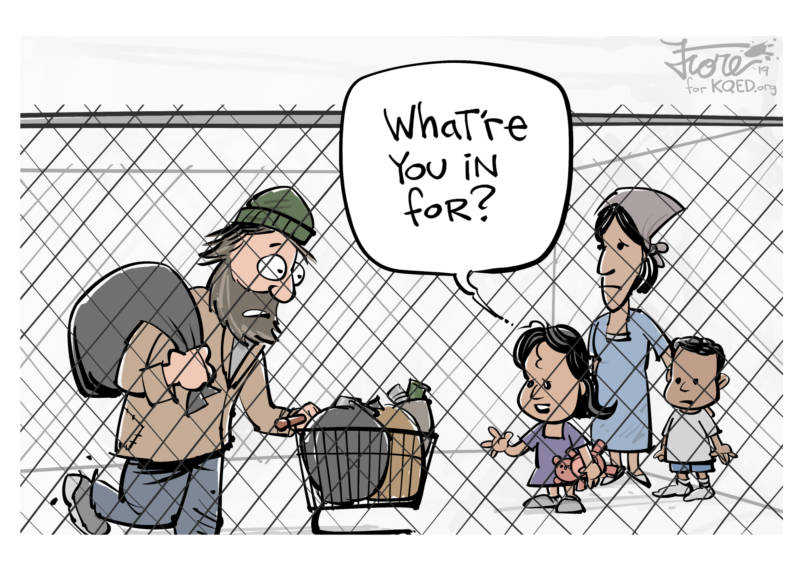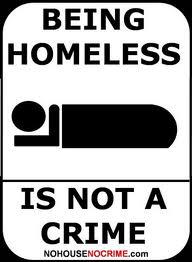Team Trump Threatens The
Destitute
By
Terry H. Schwadron, DCReport Opinion
Editor
Though the details are
not known, we do know a bit about Robert Marbut, who has been named essentially
czar for homelessness for the White House.
Marbut built a reputation for making the homeless earn admittance to shelters while clearing the streets to gather them in central holding facilities.
Marbut built a reputation for making the homeless earn admittance to shelters while clearing the streets to gather them in central holding facilities.
Marbut puts emphasis
on an approach that is less about empathy and closer to the model we know as
jail.
Formally, Marbut was
named director of the U.S. Interagency Council on Homelessness (USICH), a
position that collaborates on homelessness policy among 19 federal agencies.
His appointment was quickly condemned by housing advocates, including the
national nonprofit Invisible People, which described Marbut’s past work
as “real-life horror.”
Homeless policies are
still cooking in the White House, but the details that have emerged suggest an
approach heavier on law enforcement than empathy.
Marbut describes
himself as wielding a “velvet hammer” toward homelessness to avoid coddling
those on the street.
While whatever is
emerging as homeless policies is still cooking in the White House, the details
that have emerged suggest an approach heavier on law enforcement than empathy,
and one generally described as an attack on funds for cities and states that
are seen as places where homelessness is most visible.
For sure, homeless
populations are growing in this nation–numbers of more than 1.4 million are
said to be in various kinds of housing programs, with hundreds of thousands
more living on the streets of major cities. Concern and frustration with
homelessness as a problem crosses political boundaries, of course.
Donald Trump has been
increasingly vocal recently in criticizing cities, particularly Los Angeles and
San Francisco, for allowing homelessness to grow as opposed to looking directly
into the economic and social causes for rising numbers finding themselves in
the street.
Trump apparently sees it as good politics to try to embarrass local Democratic officials rather than working to resolve the problems.
Trump apparently sees it as good politics to try to embarrass local Democratic officials rather than working to resolve the problems.
In other words, Trump
wants to Do Something that makes it look as if homelessness is being contained
rather than examine and treat the reasons for its growth. In medical terms, he
wants the appearance of cancer going away without treating the disease.
More Money for Cops,
Less for Housing
According to Citylab.com, advocates for homeless policy say that they
expect an executive order on homelessness to assign new resources to police
departments to remove homeless encampments and even strip housing funds from
cities that choose to tolerate these encampments.
While several approaches are being reviewed by the White House’s Domestic Policy Council and the Department of Housing and Urban Development, the preferred approach is aggressiveness on the streets over attempts to provide housing first.
While several approaches are being reviewed by the White House’s Domestic Policy Council and the Department of Housing and Urban Development, the preferred approach is aggressiveness on the streets over attempts to provide housing first.
Advocates say that the
government is looking closely at ways to turn former correctional facilities
and federal buildings into shelters, a controversial approach backed by
Marbut, who has said he sees “housing fourth” rather than “housing first.”
San Antonio Model
Citylab notes that
Marbut’s career has been marked by controversy. Thirteen years ago, four years
as a San Antonio city council member, Marbut oversaw the development of a
shelter model for the city in the wake of Hurricane Katrina, when hundreds of
thousands of New Orleans residents fled to Texas cities.
The downtown facility named Haven for Hope—which calls itself a “transformational campus,” not a shelter—has been praised by state leaders and now accommodates 1,500 people as well as a wide range of services, 24 hours a day.
Access to the 1,000 beds must be earned. People entering the shelter must sleep on mats in an outdoor courtyard and can only move inside after participating in services like job training, education and substance abuse counseling. Breaking rules like missing curfew can mean getting demoted back to the courtyard.
The downtown facility named Haven for Hope—which calls itself a “transformational campus,” not a shelter—has been praised by state leaders and now accommodates 1,500 people as well as a wide range of services, 24 hours a day.
Access to the 1,000 beds must be earned. People entering the shelter must sleep on mats in an outdoor courtyard and can only move inside after participating in services like job training, education and substance abuse counseling. Breaking rules like missing curfew can mean getting demoted back to the courtyard.
Marbut became a
paid consultant for other cities. He once disguised himself as homeless to
mix with the homeless in Daytona Beach, Fla.
Increasingly, U.S.
cities have instead been trying to provide “housing first,” believing that
having shelter is a first step toward stabilizing the lives of those on the
street, particularly if children are involved.
At the same time, they want to address jobs and medical, financial or substance abuse problems. While expensive, building shelters has proved more economical than public spending on emergency care, officials say.
At the same time, they want to address jobs and medical, financial or substance abuse problems. While expensive, building shelters has proved more economical than public spending on emergency care, officials say.
Rising Numbers
But progress is slow,
especially as numbers increase, the result of economic or opiate problems.
After years of decline, the population has gone up during the Trump years.
Marbut has recommended
that cities stop giving out food, criminalize sidewalk sleeping and force
homeless residents who want services to move into city-operated facilities in
large temporary structures.
Housing and Urban Development Secretary Ben Carson has said housing for homeless residents should not be “a comfortable setting that would make somebody want to say: ‘I’ll just stay here. They will take care of me.’” Carson has moved to end some federal homelessness programs, including protections for transgenders.
Housing and Urban Development Secretary Ben Carson has said housing for homeless residents should not be “a comfortable setting that would make somebody want to say: ‘I’ll just stay here. They will take care of me.’” Carson has moved to end some federal homelessness programs, including protections for transgenders.
Policing Street
Activities
In an interview with
Huffington Post, Marbut said it is too soon to know what he will recommend.
“We’re going to be coming up with new ways to look at and address
homelessness,” he said.
The White House
Council of Economic Advisers said in a September
paper that the
“tolerability of sleeping on the street” is an important factor in the
prevalence of homelessness in a given town, a factor that could be affected by
“the policing of street activities.”
Trump wants to push
cities to round up homeless people, having called encampments disgusting and
dispatched federal officials to scout out empty facilities across the country
to be used as shelters. Ben Carson toured a large Houston shelter last week and
previously had looked at an empty federal building in California and an unused
jail in Oregon.
Texas Tribune published
a profile of Marbut that
is worth reading, including his sense that feeding people enables homelessness.
We should remember
that there is a pattern in the Trump approach to government to hide away
societal problems to make the policies he pursues look better.
This issue is worth
public debate.

